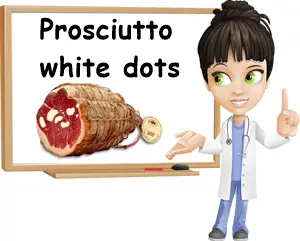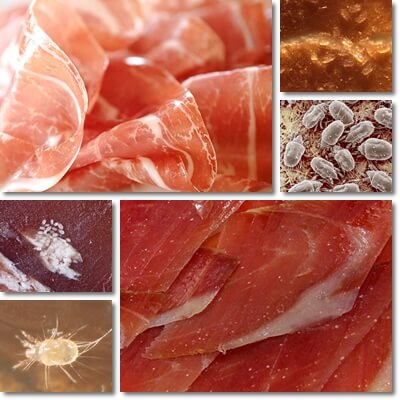If you were wondering what are those small white dots and spots on your prosciutto crudo, then you’ll be interested to know they are actually ham mites. The most common cause for white spots, dots, specks or flecks on your prosciutto crudo is the mite Tyrophagus putrescentiae, present naturally on hams such as prosciutto crudo.
Other possible causes are tyrosine crystals and white mold.
Find out how safe it is to eat prosciutto with white spots, how long will your prosciutto last and how you can tell if your prosciutto has gone bad based on how it looks.
It is common to see small white dots or spots or white flecks on prosciutto crudo, the famous traditional Italian raw (crudo), salt-cured and dried ham. Prosciutto crudo is normally redder in color, with tones of pink-red and red, crossed by thin white veins of pork fat in a beautiful marbled effect, and a thicker band of white pork fat near the rind. At times, small white spots or dots or white flecks appear on the prosciutto, both on the red meat parts and on the fatty parts.
These can occur both on individual slices (pre-sliced prosciutto) and on the exposed meat of the whole prosciutto leg once it’s cut (the cut side).

What are the white dots on prosciutto?
There are actually several things that may cause white dots, spots, specks or flecks on your prosciutto crudo. The most common cause is a ham mite, Tyrophagus putrescentiae, but white mold and tyrosine crystals are also possible causes. A fact you may find interesting is that you may find white dots on prosciutto crudo, but not cotto. The main reason why prosciutto crudo gets white spots is because it’s raw, uncooked meat – salt-cured, dried and aged meat, but still raw, uncooked meat.
Prosciutto mite (cause no. 1)
Mites don’t just live in your bedding or on your face – they are absolutely everywhere, including on your prosciutto crudo. If you notice small white spots or dots, specks or flecks on the cut side of your prosciutto leg or on your pre-sliced prosciutto, and they are moving, then you’re likely dealing with a prosciutto mite.
The scientific name is Tyrophagus putrescentiae and it’s a mite, that is, an arthropod or a really tiny insect. There are a few tens of thousands of different mite species and this one likes prosciutto. The prosciutto mite appears on prosciutto crudo because it’s raw meat, but it’s more likely to occur if the prosciutto is kept somewhere that is too warm (anything above 15-18 degrees Celsius can count as too warm) or if it’s cut and left for too long without being eaten. If the white spots, dots or flecks are moving, then they’re living mites actively eating your prosciutto. If they aren’t, then they’re dead mites and their waste material.
Is prosciutto with white spots safe to eat?
It depends. The prosciutto mites are themselves a source of protein, so they do add to the nutritional status of the prosciutto, although their contribution is minor at most. Not to mention they occur naturally on the prosciutto and they aren’t pathogenic which means they don’t make you sick if you eat them.
Some people feel that it’s safe to eat prosciutto with white spots, aka mites, so long as the ham isn’t actually filled with them to the point there are more mites than actual prosciutto. After all, eating prosciutto with the white spots doesn’t make you sick. I’ve eaten prosciutto with mites too time and time again and was ok.
However innocuous they may be, mites in general can cause side effects such as allergic reactions in some people, with side effects ranging from localized skin symptoms such as redness, itchiness and bumps on the skin (dermatitis, hives) to systemic side effects such as inflammation of the airways and other respiratory symptoms.

How to get rid of prosciutto mites, the white spots and dots on your prosciutto
As such, it is best to not buy prosciutto that has white spots on it in the first place if you have reason to be worried about allergic reaction risks, or wipe off the moving white spots from your prosciutto before eating it. You can do so with a clean cloth, either dry or soaked in some water (but remember to dry off the prosciutto afterwards to prevent spoilage).
Alternatively you can use a cooking oil such as extravirgin olive oil or sunflower oil, or better yet, pork lard or prosciutto fat. If you have yourself a whole prosciutto leg, you can first wipe off of the moving white spots from the cut side and also discard the first slice, then proceed to eat the next slice – chances are the mites haven’t gotten to it.
And an interesting fact: Tyrophagus putrescentiae, the prosciutto mite, is not only eating your prized imported Italian ham, but also drying it. If you notice your ham getting drier and there are some white specks or flecks moving on it, then it’s the mites.
Tyrosine crystals (cause no. 2)
Tyrosine crystals are crystals of the amino acid tyrosine, basically the crystallized amino acid. They occur naturally in ham, including prosciutto crudo, but also jamon serrano and jamon Iberico. Tyrosine is a non-essential amino acid found in high-protein foods such as pork meat, cheese and more.
The curing process oversees the drying of the ham meat and the breakdown of the naturally-occurring proteins in the meat into peptides and amino acids. This can lead to the formation of free amino acids that crystallize and form irregular white spots on prosciutto.
Tyrosine crystals in prosciutto are considered a sign of artisanal meat curing by some and may indicate curing without preservatives, but don’t guarantee it. Some consider tyrosine crystals in prosciutto, jamon and ham in general a defect. The crystals themselves are known to result from a slow and natural curing process that does not require the use of preservatives.
You can safely enjoy prosciutto with white spots and dots and have the satisfaction that you are eating a traditional agricultural and artisanal food product. And if the label says that no preservatives have been used, then know that the white spots and dots made that possible.
How to tell if prosciutto has mites or tyrosine crystals?
If you notice white dots, spots, specks or flecks on your prosciutto and you see some of them moving or can wipe them off, then it’s likely prosciutto mites. But if your prosciutto spots aren’t moving at all, any of them, and they are irregular in shape, more granule-like and chalky in consistency, then you likely have yourself tyrosine crystals.
White mold on prosciutto (cause no. 3)
Is it possible for prosciutto to get moldy? Absolutely! Those who make their own prosciutto crudo at home and do not have complete control over factors in their environment such as humidity or temperature may find their prosciutto growing mold.
It can be your usual blue-green-gray hairy mold or a white mold. The problem with mold is that you don’t always know if it’s edible mold or a pathogenic, dangerous mold. A mold that just happens to grow on your ham is not automatically safe to eat just because you were curing ham – it may very well be pathogenic and cause disease in which case it can make you very sick.
Prosciutto mold is a very real issue, especially for small prosciutto artisans. Small white dots of mold can appear on the prosciutto rind and, more commonly, on the ham inside. This is likely due to increased humidity, either environmental or in the cured meat. Prosciutto mold from the rind can be removed safely, but white mold on the inside of the prosciutto is more problematic. If it’s only on the first slice or the first part of the ham, you can try and trim the ham until you get to a part without mold. But if the whole prosciutto is contaminated, then it’s best to just discard it.
How long does prosciutto last?
Pre-sliced prosciutto lasts for as long as it says on the label, so check the expiration date. So far, most of the pre-sliced prosciutto I’ve got was good for 2-3 weeks tops if refrigerated and left in the unopened package. But once the package is open, it doesn’t just requires refrigeration, but also needs to be consumed in a certain amount of time, usually under 1 week.
I’d eat the prosciutto in a couple of days. Leaving it in the fridge for more than 3 days will cause the ham meat to start to oxidize and lose color and flavor.
It’s also best to keep it covered while refrigerated.
The whole prosciutto leg is cured for at least 12-13 months and up to 2-3 years, the original PDO, Protected Designation of Origin (DOP in Italian) prosciutto that is.
So long as you don’t start it, it can last for well over a year, given it’s kept in a cool, dark and especially dry place. Once cut, the whole prosciutto leg needs to be kept in a cool and dry place, with the cut side covered to protect it and create somewhat of a barrier against humidity.
And, of course, eaten. But it can last a long time if stored properly, around a year.
How to tell if prosciutto has gone bad?
Here are the signs to look for in your prosciutto in order to be able to tell if it’s fresh or has gone bad:
- Color: Prosciutto crudo should have a bright, deep red color if it’s fresh and still good to eat. As it oxidizes, it slowly loses its bright color. Prosciutto that is grayish-red or brownish-red or looks washed out is no longer at peak freshness.
- Taste: Fresh prosciutto crudo has a somewhat smoked-meat aftertaste with pregnant salty flavor notes, in some cases even faint sweet flavors. It’s overall delicate and definitely tastes like a cured pork meat. But if it’s gone bad, you will definitely be able to tell from its taste.
- Smell: Prosciutto smells like cured ham, with somewhat heavy flavors, but nonetheless fresh. You can tell if it is bad by an uninviting smell – if you eat it regularly, you’ll know right away if it’s fresh or not.
- Fluffy or hairy mold, whether white or blue, gray or green, is a clear indication the prosciutto has gone bad and should no longer be consumed at this point.
